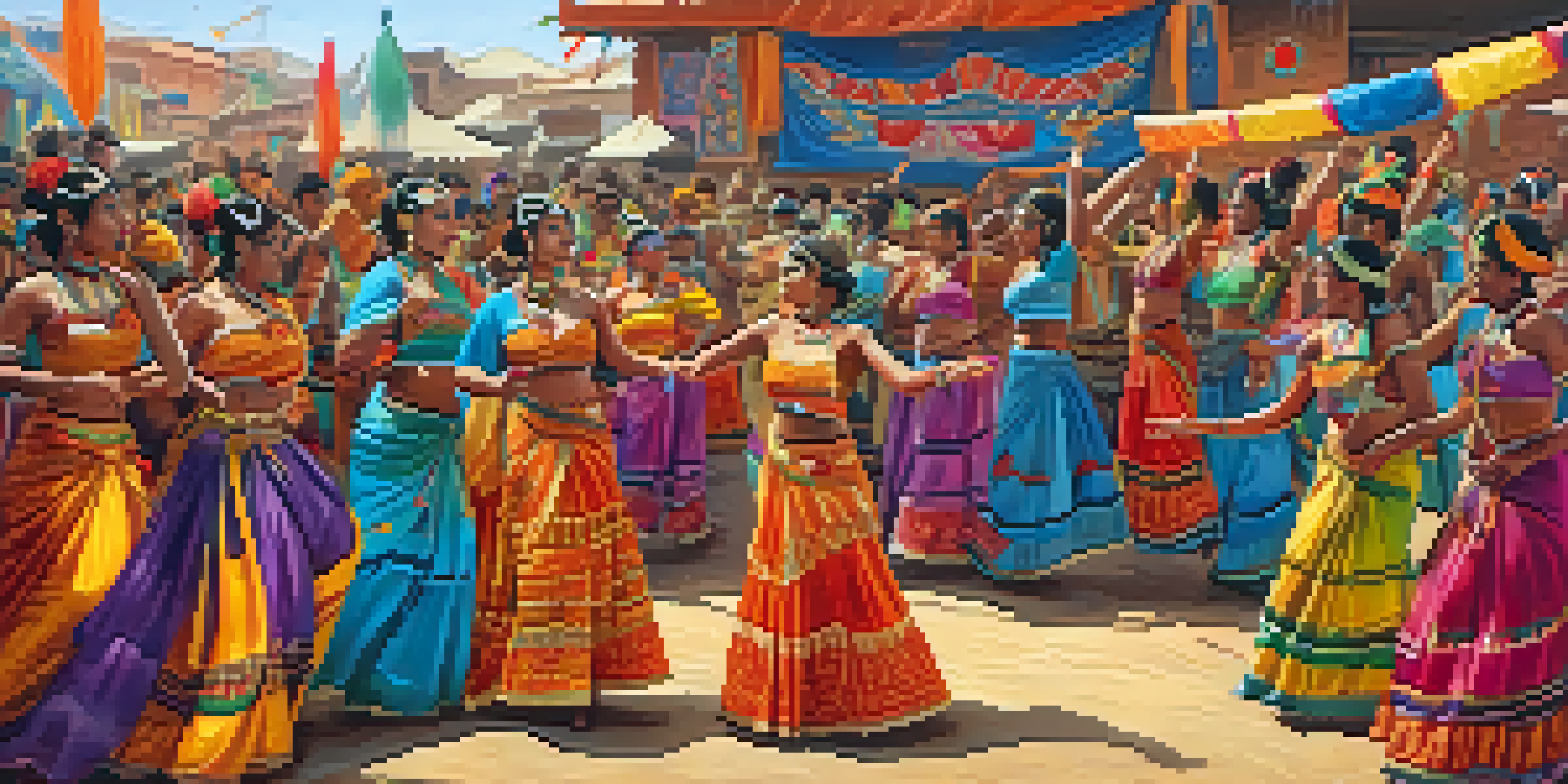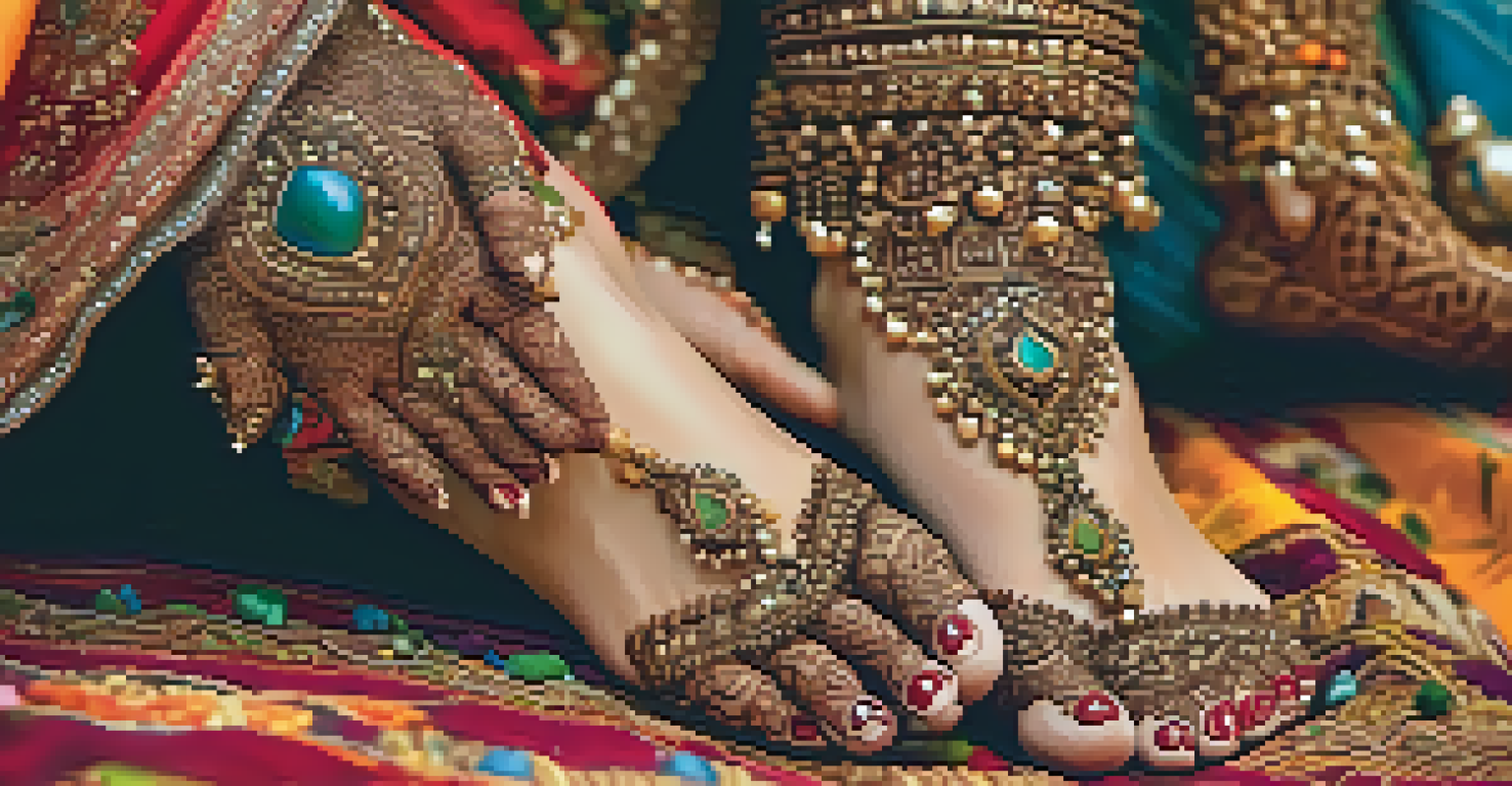Rituals and Body Painting: Connections Across Different Cultures

The Meaning of Body Painting in Cultural Rituals
Body painting serves as a powerful form of expression across various cultures. It often embodies significant meanings, representing identity, beliefs, and social roles. For example, in many Indigenous tribes, body paint is not just decoration but a vital part of rituals that convey messages about heritage and community.
Art is the most beautiful of all lies; it is the mirror of our culture and time.
In some cultures, body painting is used to signify important life events, such as coming of age or marriage. These colorful designs can symbolize a person's new status and are often accompanied by specific rituals that enhance their meaning. This connection between body art and life transitions highlights the deep cultural significance of these practices.
Furthermore, the techniques and materials used for body painting can vary widely, from natural pigments sourced from plants to intricate designs that require skilled craftsmanship. This diversity reflects the unique cultural narratives and histories of each community, showcasing how body painting is intertwined with ritualistic practices.
Rituals of Protection and Healing Through Body Art
In many cultures, body painting serves a protective purpose, believed to ward off evil spirits or misfortune. For instance, in some African traditions, tribal markings are applied during specific ceremonies to bring strength and protection to individuals. This practice highlights the spiritual connection that body painting can create within a community.

Moreover, body painting is also seen as a healing ritual in various cultures. In certain Indigenous practices, specific designs are painted onto the skin to promote physical or spiritual healing, often during ceremonies led by a shaman or spiritual leader. This blend of art and spirituality reflects the belief that body paint can channel positive energy and aid in recovery.
Cultural Significance of Body Painting
Body painting serves as a profound form of expression that conveys identity, beliefs, and social roles within various cultural rituals.
The symbolism associated with these protective and healing rituals is often passed down through generations, creating a rich tapestry of shared beliefs and practices. Such rituals demonstrate the essential role that body painting plays in fostering community bonds and personal resilience.
Ceremonial Body Painting: Festivals and Celebrations
Festivals around the world often feature body painting as a central element, celebrating cultural heritage and community identity. Take, for instance, the annual Carnival in Brazil, where vibrant body art enhances the festive spirit and allows participants to express their creativity. These celebrations highlight how body painting can foster unity and joy within a culture.
Body art has the power to tell stories that are often left untold, weaving the threads of history, culture, and identity into a single tapestry.
In addition to festivals, significant life events often include body painting as part of the ceremonial practices. In Hindu weddings, for example, intricate henna designs are applied to the bride's hands and feet, symbolizing beauty and good fortune. Such traditions underscore the importance of body art in marking life's milestones.
These ceremonial practices are not just about aesthetics; they connect individuals to their cultural roots. By participating in these rituals, people embrace their heritage and strengthen their sense of belonging within the community.
The Role of Body Painting in Spiritual Practices
Body painting often intertwines with spiritual beliefs, serving as a form of communication between the earthly and the divine. In many Indigenous cultures, specific designs are painted on the body during rituals to invoke spiritual energies or honor ancestors. This practice illustrates the sacred nature of body art in connecting individuals to their spiritual beliefs.
Additionally, body painting can be a way to express devotion or seek guidance from higher powers. For example, in some Asian cultures, practitioners may paint symbols or mantras on their bodies as a form of meditation or prayer. This emphasizes the idea that body art is not merely ornamental but can carry profound spiritual significance.
Body Art in Protection and Healing
In many cultures, body painting is used as a protective and healing ritual, believed to ward off evil and promote physical and spiritual well-being.
Through these practices, body painting becomes a dynamic medium for exploring and expressing spirituality. It serves as a reminder of the deep connections that exist between art, faith, and cultural identity.
Historical Perspectives on Body Painting and Rituals
Body painting has a long history, with archaeological evidence suggesting its use in ancient rituals across different civilizations. From the intricate designs of the ancient Egyptians to the tribal markings in prehistoric Europe, body art has been a form of storytelling that transcends time. This historical dimension adds depth to our understanding of its cultural significance.
In various cultures, historical accounts reveal how body painting was used to signify social status or tribal affiliation. For instance, the Maori of New Zealand have a tradition of Ta Moko, which involves tattooing and painting the skin to represent lineage and personal achievements. This practice highlights how body art has historically served as a visual narrative of identity.
By studying these historical perspectives, we can appreciate the enduring nature of body painting and its role in shaping cultural identities over centuries. It reveals how art and ritual have been intertwined throughout human history, creating a rich legacy that continues to influence modern practices.
Modern Interpretations of Body Painting and Rituals
In today's world, body painting has evolved into a contemporary art form, merging traditional practices with modern influences. Artists now experiment with various styles, techniques, and materials, creating stunning visual expressions that resonate with contemporary audiences. This evolution reflects the dynamic nature of culture and art.
Moreover, body painting has found its way into mainstream events such as music festivals and fashion shows, where it is celebrated as a form of self-expression. Events like the Coachella Music Festival showcase elaborate body art as a means for individuals to express their unique identities and artistic visions. This shift highlights the growing acceptance of body painting in diverse contexts.
Evolution of Body Painting Practices
Modern interpretations of body painting blend traditional practices with contemporary influences, creating new forms of self-expression while respecting cultural origins.
However, while modern interpretations celebrate creativity, it's essential to honor the cultural origins and meanings of traditional practices. As body painting continues to evolve, maintaining respect for its historical and spiritual significance will ensure that these rich traditions endure.
Cultural Exchange and the Global Influence of Body Painting
The globalized world has facilitated a rich exchange of cultural practices, including body painting. As people travel and connect through social media, ideas and techniques from different cultures are shared and adapted. This cultural blending can lead to innovative practices that honor tradition while embracing modernity.
For instance, contemporary artists may draw inspiration from traditional tribal designs, incorporating them into their work while providing new interpretations. This cross-cultural dialogue fosters appreciation and understanding, allowing body painting to transcend its original context and reach new audiences.

However, it is crucial to approach this exchange with sensitivity and respect for the cultures that originated these practices. By acknowledging the roots of body painting and promoting ethical engagement, we can celebrate its diverse expressions while honoring its cultural significance.
The Future of Body Painting and Cultural Rituals
As we look to the future, body painting and cultural rituals are likely to continue evolving, reflecting shifts in societal values and artistic expressions. The rise of digital platforms offers new opportunities for artists to showcase their work and connect with wider audiences. This democratization of art can lead to exciting innovations in body painting practices.
Moreover, as awareness of cultural appropriation increases, there is a growing emphasis on respecting and preserving traditional practices. Collaborations between artists from different backgrounds can foster understanding and promote culturally sensitive representations in body painting. This approach encourages a future where art is both innovative and respectful of its origins.
Ultimately, the future of body painting lies in its ability to adapt while honoring its rich traditions. By embracing change and fostering cultural appreciation, body painting can continue to serve as a vibrant medium for expression and connection across diverse cultures.